The Energy Secretary Pushes Pseudoscience
The Drain is a weekly roundup of environmental and climate news from Legal Planet.
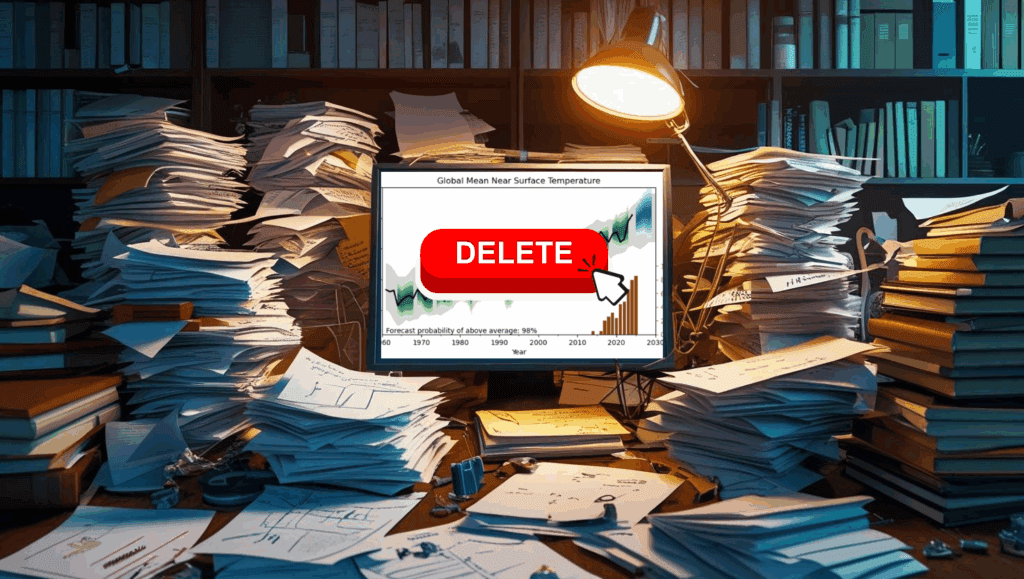
Remember alternative facts? That catch phrase from Season 1, Episode 1 where Trump officials lied about the size of his inauguration crowd has now metastasized into a governing philosophy for how federal agencies plan to ignore, and ultimately exacerbate, the climate crisis.
Trump 2.0 is pushing alternative science. Late last month, Energy Secretary Chris Wright and the Energy Department rushed a report called “Critical Review of Impacts of Greenhouse Gas Emissions on the U.S. Climate,” by 5 authors handpicked by Wright (a former fossil fuel executive) for their contrarian views on climate science. It argues that some of the warming attributed to the burning of fossil fuels is instead driven by natural cycles or variability in the sun; that CO2-induced warming appears to be less damaging economically than thought; and that aggressive mitigation strategies could hurt more than help us. It was released on the same day that Trump’s EPA announced it plans to revoke the all-important Endangerment Finding.
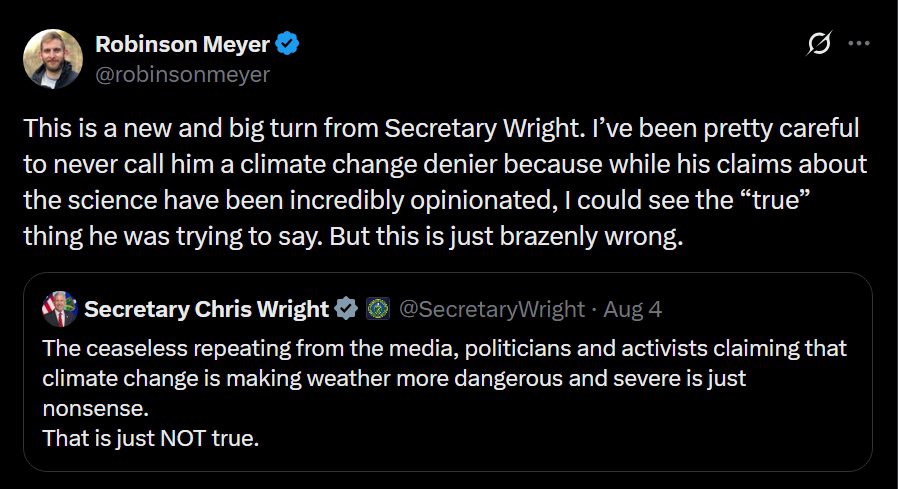
This all flies in the face of well-established science so climate scientists swiftly pushed back. Zeke Hausfather gives a detailed account of how his own research was misquoted, misrepresented, and misused in the Energy Department report. “It cherry-picks figures and parts of studies to support a preconceived narrative that minimizes the risk of climate change,” Hausfather writes. Andrew Dessler, a climate scientist at Texas A&M University, has crowd-sourced a response from climate scientists. The Energy Department is accepting public comment on its report through September 2.
Dessler calls the Energy Department report a “law brief from attorneys defending their client, carbon dioxide.” They’ve selected evidence to support their narrative — including obscure figures, supplementary material, and what could generously be called alternative facts. Here’s how Kellyanne Conway explained away her much-maligned catch phrase. “Two plus two is four. Three plus one is four. Partly cloudy, partly sunny. Glass half full, glass half empty. Those are alternative facts.” That’s one way to debate, but it’s not science.
What’s important to understand about the Energy Department’s report is that it functions as a “back-up argument aimed at the courts,” as Harvard’s Jody Freeman puts it in a recent podcast about the endangerment finding. “The courts don’t know the science. So, there’s a play here to say, ‘We should have maximum space to exercise our discretion,’” Freeman says. While agencies like EPA and DOE may not be given as much deference as they used to, they still have discretion over factual findings. What about alternative factual findings?
Let’s just call it pseudoscience. A couple of environmental groups argue that convening a secretive working group to draft such a foundational government report is also illegal. The Environmental Defense Fund and the Union of Concerned Scientists just filed a lawsuit claiming it violates the Federal Advisory Committee Act.
The administration is going beyond just publishing an alternative. They’d like to rewrite science. Wright told CNN last week that the administration intends to alter previous National Climate Assessments — Congressionally mandated reports that were already published but recently removed from government websites. Thankfully, US scientists aren’t backing down. A new self-funded National Academies of Sciences, Engineering, and Medicine study will review the “latest scientific evidence on whether greenhouse gas emissions are reasonably anticipated to endanger public health and welfare in the U.S.”
But the ripples can already be seen far outside Washington. I found myself listening to alternative facts last week during a public forum on neighborhood decarbonization projects held by the California Public Utilities Commission. The CPUC is leading a process of creating up to 30 gas-free neighborhood priority zones. (I write more about that here.)
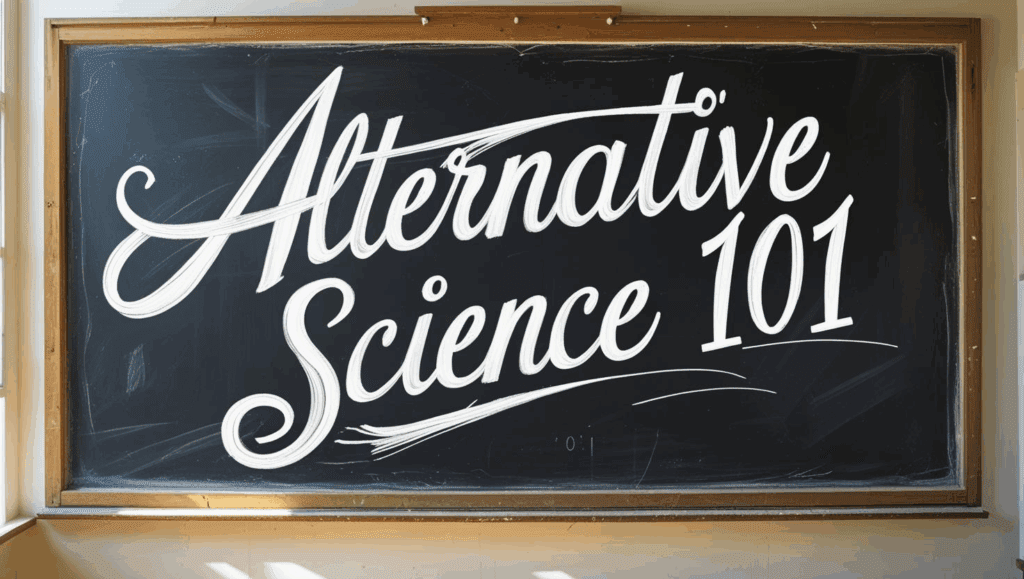 Some of the Californians who wrote and called in to comment at the CPUC mentioned the Energy Department’s report by name. “The report also addresses global climate models, the attribution of climate change, and a range of other topics to present the most current understanding of climate science,” one person wrote to oppose the pilot projects. “Currently the EPA is on its way to cancel the Democrats CARBON FEAR Program by reversing the rules and regulations on Carbon emissions. It is a hoax.”
Some of the Californians who wrote and called in to comment at the CPUC mentioned the Energy Department’s report by name. “The report also addresses global climate models, the attribution of climate change, and a range of other topics to present the most current understanding of climate science,” one person wrote to oppose the pilot projects. “Currently the EPA is on its way to cancel the Democrats CARBON FEAR Program by reversing the rules and regulations on Carbon emissions. It is a hoax.”
“This massive tax dollar-wasting infrastructure reform is based on the false premise that CO2 greenhouse emissions cause climate change,” another person wrote. “Please keep in mind that the EPA administrator Lee Zeldin is working to eliminate the 2009 endangerment finding.”
Previously, these comments could be treated simply as anti-science outliers. They still are. But now they can also be viewed as citizens sharing the official U.S. government position.
Welcome to The Drain, a weekly roundup of environmental and climate news that tries to drain the flood zone. Here’s some better news…
Good News
The nonprofit Climate Central plans to revive a key federal database tracking billion-dollar weather disasters that the Trump administration formally stopped updating in May, reports Lauren Rosenthal at Bloomberg. The database formerly produced by NOAA will return in fall and Climate Central “has hired Adam Smith, the former NOAA climatologist who led the disaster tracker for more than a decade, to continue tallying the growing number of storms, droughts and wildfires.”
And after the EPA said it will discontinue a well-used database that helps companies calculate their greenhouse gas emissions, it will now be housed at Stanford University as its creator is leaving the EPA to continue his work there, reports Harry Stevens at the New York Times.
An avowed climate hawk will be No. 2 for Dems in the US Senate. Senator Brian Schatz, the Democrat from Hawaii who has given plenty of passionate climate speeches from the floor, secured enough votes last week to replace Illinois Senator Dick Durbin as the Democrats’ whip.
Ford unveiled a new EV strategy. The automaker will invest nearly $2 billion to improve a Kentucky factory to produce electric vehicles that it says will be more affordable, more profitable to build and will outcompete rival models. It’s all about the assembly line not the car, writes Andrew Moseman at Heatmap News.
Bad News

The EPA said Friday it will no longer recognize its federal unions and that all collective bargaining agreements are terminated, effective immediately. It’s the second agency to do so, reports the Federal News Network. AFGE Local 238, representing 8,000 + EPA employees, called it unlawful and plans to sue.
Meanwhile “the enforcement of environmental laws has fallen off a cliff.” The DOJ filed just 11 civil lawsuits against major polluters for breaking bedrock environmental laws, compared with 30 of these cases in Biden’s first full six months in office. Far fewer settlements too, according to the NYT.
The Trump administration’s suspension of grants at UCLA totaling $584 million has imperiled research in an array of subjects including: potentially lifesaving breakthroughs in cancer treatment and tools to more easily diagnose debilitating diseases. (A federal judge has ordered about a third of the federal grants restored for now.)
The Supreme Court’s approval rating has sunk to an all-time low, dropping below 40% for the first time, according to a new Gallup poll.
California and cities
My UCLA Emmett Institute colleague Mary Nichols spoke with US News & World Reports about Trump’s war on EVs for a story previewing the “highly anticipated list of recommendations” that CARB is scheduled to make to Gov. Newsom this week. “California is moving forward with electric cars,” Nichols says. “It’s still moving forward, as is the rest of the world, and we’re going to continue to do that.”
There’s good news in Kern County where LA leaders and clean energy experts gathered last week to open LADWP’s Eland solar-plus-storage electricity project. LAT’s Hayley Smith was there and noted that the project’s 1.36 million solar panels and 172 lithium iron phosphate batteries are “as large as 13 Dodger stadiums, parking lots included, and will generate 7% of the electricity for all of the city of Los Angeles, much of it at a record-low price.”
And yet Gov. Newsom is pushing a draft bill that would boost oil drilling in Kern County, a big pivot from previous legislative sessions that cracked down on oil industry price gouging to address prices, Politico’s Alex Nieves explains.
And later today (Wednesday), the California Energy Commission is scheduled to vote on whether to officially pause implementing the penalty on oil companies for excessive profits.
Staying in Sacramento, two of the most notable “energy affordability” bills in Sacramento are moving forward — SB 254 (Becker), and AB 825 (Petrie-Norris) both include provisions that would force the big three utilities to accept public financing for a portion of the tens of billions they plan to spend on their power grids. “This is different from what we’ve seen in the past — and the solutions being sought by the legislature are more ambitious than what we’ve seen in recent years,” Matthew Freedman from TURN told Jeff St. John.
Ahead of a heat wave, the LA County Board of Supervisors voted last week to soon require landlords to maintain a maximum indoor temperature of 82°F for their renters. “After years of consideration, the Board of Supervisors voted 4-0 Tuesday to pass the county’s first cooling mandate in rental housing,” LAist reports.
There are renewed calls for LA to stop raiding Mono Lake for water, Ian James reports for LAT. “A landmark 1994 decision by state water regulators limited L.A.’s water diversions and set a target for raising the lake’s level. But 31 years later, that requirement has not been met.”
New research published in the Journal of the American Medical Assn. estimates LA County experienced 440 more deaths than typically expected between Jan. 5 and Feb. 1 directly after climate-driven Eaton and Palisades fires, which technically have a death count of just 31 people.
San Francisco is looking to fast-track all-electric building standards, Alison F. Takemura reports. The Board of Supervisors completed the first of two votes to pass the All-Electric Major Renovations Ordinance that will apply to commercial and residential structures. “The initial 11–0 vote was a resounding sign of approval; the final hearing is likely to occur Sept. 2.”
U.S. EPA officials have agreed to issue a decision by Sept. 15th on whether California’s Central Valley is out of compliance with federal standards for smog-forming ozone.
If Congress fails to extend California’s Clean Air Vehicle Decal program, the state’s EV drivers could lose their two-decadeslong carpool lane privileges in September.
And big truck makers are trying to renege on a deal they struck with CARB that was designed to encourage compliance with tougher emissions standards, pointing at the Trump administration’s interventions.
Rooftop solar wars continue and California’s Supreme Court gave homeowners with rooftop solar panels a small victory last Thursday by directing a lower court to revisit its earlier decision to uphold compensation rates for solar installations, writes CalMatters’ Malena Carollo.
Groups opposed to Sable Offshore restarting oil drilling off the coast of Santa Barbara are planning to speak at the California Coastal Commission meeting today through Friday in Calabasas.
Fires, Disasters, and Extreme Weather
Surging wildfires in the Amazon pose a threat to the success of Brazil’s Tropical Forests Forever Facility (TFFF) and other innovative finance tools that will be showcased at COP30, Tiffany Higgins writes for Climate Home News.
Global warming has advanced wildfire season from one to almost seven weeks earlier, a new UCLA study shows. The IoES study found that fuel aridity had the strongest influence on year-to-year shifts in the timing of the onset of fire season.
The Center for Climate Integrity released a new report titled “How Big Oil is Fueling the Insurance Crisis — And Why State Policymakers Should Act” outlining how fossil fuel pollution contributes to destabilized insurance markets nationwide. The group supports ongoing legislative efforts to make the fossil fuel industry shoulder the financial burden.
Climate fueled wildfires, like LA’s January firestorms, take a toll on our brains and bodies. Corinne Purtill writes at Boiling Point about the physical burden we all take on when the environment falls apart.
Plastics
International treaty negotiations over plastic pollution resumed in Geneva, Switzerland last week and continue to August 14. Joseph Winters writes at Grist that these are the major coalitions and groups to watch during the treaty’s sixth negotiating session.
But the Trump administration has opted to “forcefully oppose any measures aimed at curbing plastic production that could potentially threaten the country’s powerful petrochemical industry,” Climate Home News reports.
Rebecca John at DeSmog reports on a newly unearthed document, a letter written in May 1974 by Charles Brelsford McCoy, a president and board chairman of DuPont, which “represents the earliest evidence to date of a top-level industry insider admitting that many commonly used plastic products cannot be recycled due to their complex chemical structures.”
Energy
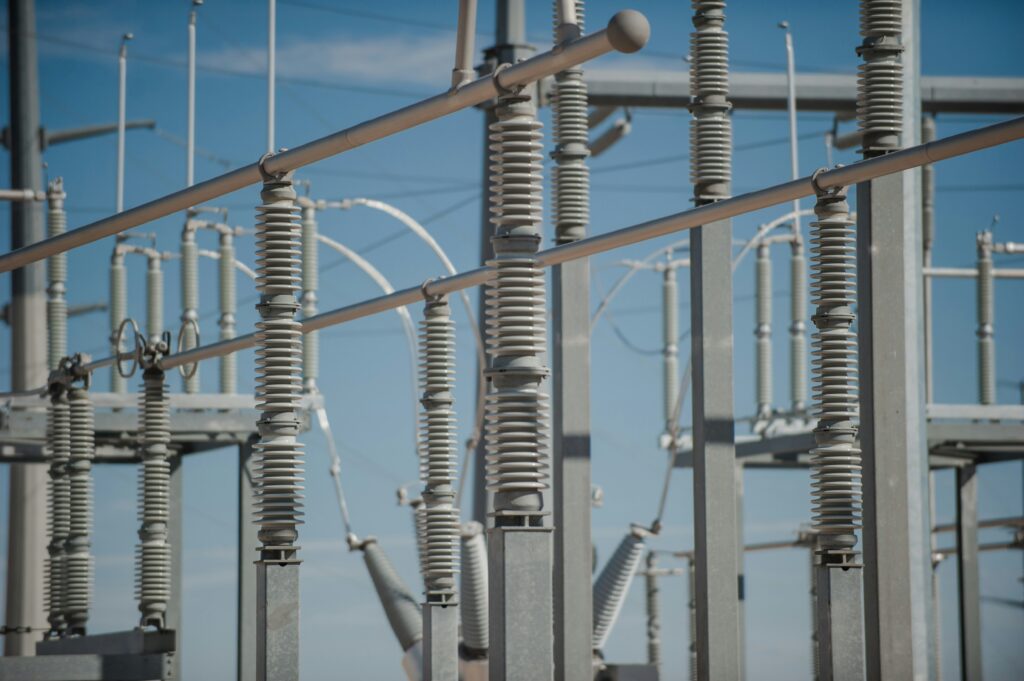
US demand for electricity broke records twice last month: a high of 758,053 megawatts on July 28 and then 759,180 megawatts on July 29 – that’s nearly 2% above the previous record set on July 15, 2024.
This new report from Harvard’s Electricity Law Initiative projects that U.S. consumers will pay billions of dollars to build new power plants to serve Big Tech. The authors reviewed nearly 50 regulatory proceedings about utility rates for data centers to explain “how utilities are forcing ratepayers to fund discounted rates for data centers.”
The administration has canceled a major wind farm development in Idaho called the Lava Ridge Wind Project northeast of Twin Falls, a project approved late in Biden’s term. AP reports that the project was 5 years in the works. Idaho Capital Sun says 40% of Idaho’s energy comes from out of state.
Interior Secretary Doug Burgum now must personally bless dozens of permits with the goal of slowing project timelines and he announced last week that his department will review all offshore wind energy regulations. In fact, the Trump administration just announced that it might block every wind energy project in America, notes Michael Thomas. Don’t believe them when they say they are trying to protect bald eagles, writes Benji Jones at Vox.
Trump’s EPA is trying to kill the $7B “Solar for All” program, just as it starts to deliver on its goal of building low-cost solar projects to slash bills for nearly 1 million families and help bolster the grid, Jeff St. John reports at Canary Media. Cue the lawsuits. Almost none of the $250 million that California got for Solar for All has made it out the door yet, Politico reports.
Emily Atkin makes an appeal at Heated to stop saying “the clean energy revolution can’t be stopped” because it gives a deceptive sense of inevitability. “Special interests in the US are currently slowing the renewable energy transition to such a degree that, by time the world has largely weaned itself off fossil fuels, unthinkable and irreversible climate catastrophes will have already occurred,” Atkin writes.
Indeed, America is “acting like a doddering industrial giant — too hooked on oil and gas revenues, and the political power that results from them, to exercise the economic muscles it will need in the future,” writes Robinson Meyer in a new NYT Opinion article.
Other items worth your time
A Supreme Court “shadow docket” decision expected within days could affect thousands of federal grant recipients battling the Trump administration over the termination of their funding for projects including for climate and environmental justice work, Jean Chemnick reports at E&E News.
L.A. Times staffers have assembled a “Future of L.A. project” that looks at the region’s readiness for tolerating a “Day Zero” without water, fires of the future, and the death of all our palm trees.
The meat industry desperately wants to persuade people to “feel better” about eating beef, despite that sector’s massive emissions of climate pollution, according to a DeSmog report on a public relations strategy document. The meat industry may have enlisted environmental groups to help in the PR campaign.
Some city workers tell Alissa Walker at Torched that LA’s leaders risk striking a bad deal with LA28 that could put taxpayers on the hook for $1.5 billion or more. “LA28’s opaque finances and vague reassurances are not enough to protect the city from fiscal disaster,” says former chief deputy controller Rick Cole.
My former colleague Caleigh Wells writes a first-person narrative for the Associated Press Climate Watch newsletter all about her efforts to make a new home more efficient. Sounds like she’s facing down the same challenge of needing to upgrade the electrical panel before she can put in a heat pump. Same here. I’ll race you, Caleigh!




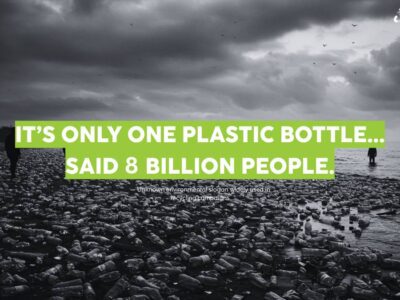
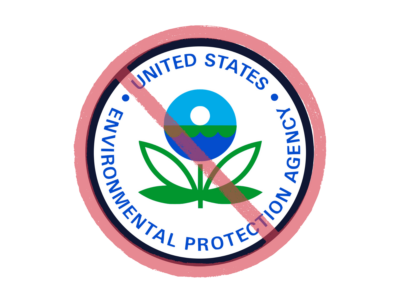
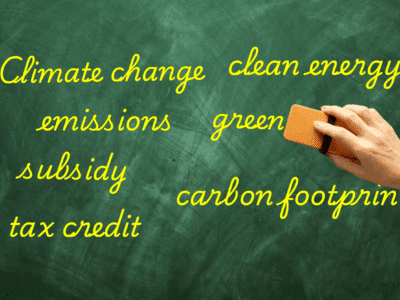
Reader Comments